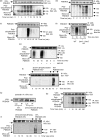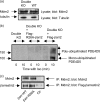Mdm2 directs the ubiquitination of beta-arrestin-sequestered cAMP phosphodiesterase-4D5
- PMID: 19372219
- PMCID: PMC2713507
- DOI: 10.1074/jbc.M109.008078
Mdm2 directs the ubiquitination of beta-arrestin-sequestered cAMP phosphodiesterase-4D5
Erratum in
- J Biol Chem. 2009 Aug 7;284(32):21776
Retraction in
-
Withdrawal: Mdm2 directs the ubiquitination of β-arrestin-sequestered cAMP phosphodiesterase-4D5.J Biol Chem. 2020 Aug 21;295(34):12328. doi: 10.1074/jbc.W120.015374. J Biol Chem. 2020. PMID: 32826336 Free PMC article. No abstract available.
Abstract
Beta-arrestin plays a key role in regulating beta2-adrenoreceptor signaling by interdicting activation of adenylyl cyclase and selectively sequestering cAMP phosphodiesterase-4D5 (PDE4D5) for delivery of an active cAMP degrading system to the site of cAMP synthesis. Here we show that the beta-agonist, isoprenaline, triggers the rapid and transient ubiquitination of PDE4D5 in primary cardiomyocytes, mouse embryo fibroblasts, and HEK293B2 cells constitutively expressing beta2-adrenoceptors. Reconstitution analyses in beta-arrestin1/2 double knockout cells plus small interference RNA knockdown studies indicate that a beta-arrestin-scaffolded pool of the E3-ubiquitin ligase, Mdm2, mediates PDE4D5 ubiquitination. Critical for this is the ubiquitin-interacting motif located in the extreme C terminus of PDE4D5, which is specific to the PDE4D sub-family. In vitro ubiquitination [corrected] of a PDE4D5 spot-immobilized peptide array, followed by a mutagenesis strategy, showed that PDE4D5 ubiquitination occurs at Lys-48, Lys-53, and Lys-78, which are located within its isoform-specific N-terminal region, as well as at Lys-140 located within its regulatory UCR1 module. We suggest that mono-ubiquitination at Lys-140 primes PDE4D5 for a subsequent cascade of polyubiquitination occurring within its isoform-specific N-terminal region at Lys-48, Lys-53, and Lys-78. PDE4D5 interacts with a non-ubiquitinated beta-arrestin sub-population that is likely to be protected from Mdm2-mediated ubiquitination due to steric hindrance caused by sequestered PDE4D5. Ubiquitination of PDE4D5 elicits an increase in the fraction of PDE4D5 sequestered by beta-arrestin in cells, thereby contributing to the fidelity of PDE4D5-beta-arrestin interaction, as well as decreasing the fraction of PDE4D5 sequestered by the scaffolding protein, RACK1.
Figures








References
-
- Beavo J. A., Brunton L. L. ( 2002) Nat. Rev. Mol. Cell Biol. 3, 710– 718 - PubMed
-
- Taskén K., Aandahl E. M. ( 2004) Physiol. Rev. 84, 137– 167 - PubMed
-
- Taylor S. S., Kim C., Vigil D., Haste N. M., Yang J., Wu J., Anand G. S. ( 2005) Biochim. Biophys. Acta 1754, 25– 37 - PubMed
-
- Wong W., Scott J. D. ( 2004) Nat. Rev. Mol. Cell Biol. 5, 959– 970 - PubMed
-
- Conti M., Beavo J. ( 2007) Annu. Rev. Biochem. 76, 481– 511 - PubMed
Publication types
MeSH terms
Substances
Grants and funding
LinkOut - more resources
Full Text Sources
Other Literature Sources
Molecular Biology Databases
Research Materials

